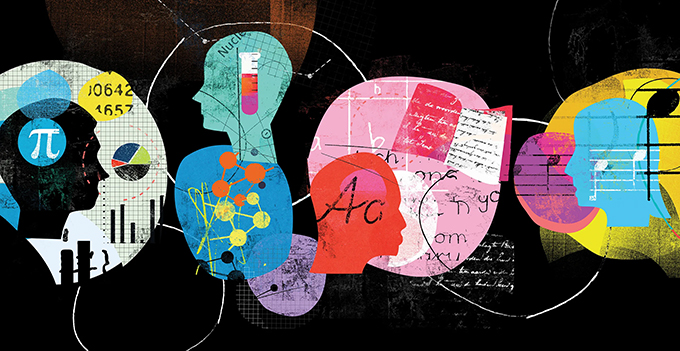
Surely on more than one occasion we have had to answer the question of whether we are “science or humanities” as if there were no other way to classify ourselves. Or we have resorted to the explanation: “It’s that I am a science (or humanities) person” to get around an uncomfortable situation or justify our position.
This division of knowledge into two large areas dates back to antiquity and was accentuated after the Industrial Revolution in the 19th century. Ken Robinson , writer and lecturer, pointed out that from the beginning of the capitalist production model the educational system was oriented towards economic-productive growth. This meant that science began to occupy a preeminent place over literature.
Although authors such as Nuccio Ordine have defended the importance of certain areas of knowledge such as philosophy, literature and art in order to understand the world we live in, and without which scientific disciplines would not have developed as they have, reality is constructed socially , and there is an arsenal of stereotypes and value judgements hidden behind this dichotomy between science and humanities that insinuate or point out that “those in science” are analytical, objective, practical and decisive, while “those in humanities” are nothing more than emotional, subjective, theoretical and procrastinators.
There has even been a search for a biological origin and supposed differences in the anatomical structure of the brain that could explain the split between people of science and people of letters. Considering that intelligence can be shaped by environmental pressure , it seems risky to claim that the shape of the brain can determine a person’s preferences or aptitudes .
The origin of intelligence
Although the mechanisms of intelligence inheritance have been investigated for decades, it is not clear to what extent intelligence is inherited or constructed, being most likely a mixture of both perceptions. The so-called intelligence quotient or intelligence coefficient, abbreviated as IQ, is a score obtained through standardized tests.
The score obtained in tests such as the Wechsler Adult Intelligence Scale is obtained by projecting the subject’s measured range onto a Gaussian bell curve, formed by the distribution of possible values for his or her age group, with a central value (average intelligence) of 100 and a standard deviation of 15%. In general, this type of intelligence test only measures traditional logical-mathematical and linguistic schemes.
Gardner and his multiple intelligences
In the 1980s, Howard Gardner proposed a pluralistic vision: his approach understands intelligence as a changing process that develops based on the individual’s experiences over the course of his or her life.
Gardner’s studies on this theory of “multiple intelligences” consider intelligence not as a unitary thing but as the grouping of a set of distinct and independent intelligences.
How we measure multiple intelligences
Gardner not only departs from the official orthodoxy that conceives intelligence from a single perspective, but also departs from the way in which intelligence is identified and quantified through tests, stating that humans are better defined through their different intelligences and avoiding the traditional division between science or letters.
More specifically, he speaks of eight major types of intelligence: musical, kinetic-bodily, logical-mathematical, linguistic, spatial, interpersonal, intrapersonal and naturalist, although currently the American psychologist , winner of the 2011 Prince of Asturias Award for Social Sciences, has extended the range to twelve .
Empirical basis?
One of the criticisms of Gardner is his controversial empirical-demonstrative basis , which does not mean that traditional IQ measurement models are conclusively above the theory of multiple intelligences .
Gardner’s theory offers a new space for reflection to understand what intelligence is. It focuses on what intelligence is, how it can be measured and how many types there are: it argues that intelligence cannot be quantified but rather has to do with certain potentialities, which are activated or not according to the values of a given culture, the opportunities available and the decisions made by each person, their family or other agents of socialization.
Neither science nor literature: more possible combinations
This dichotomy between science and humanities, beyond the vocation it may inspire in people, should only be a small part of the choice model proposed by the educational system. As the only guide, it limits us both in our academic career and in our subsequent professional path, when there are so many other combined options. Or would a footballer not be able to combine his physical ability with kinetic-corporal, spatial and intrapersonal intelligence, for example?
Perhaps, for all these reasons, it is interesting to reconsider the initial question and begin to ask: “How do you distribute your intelligences?” So that, in the end, we cannot boast of others that are neither the sciences nor the “traditional” arts.
Author Bio: Angel Jose Olaz Captain is Professor of Sociology, Methods and Techniques of Social Research at the University of Murcia
